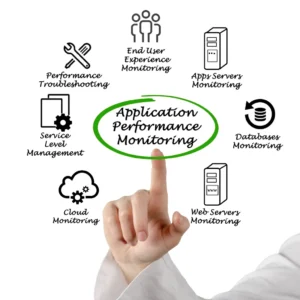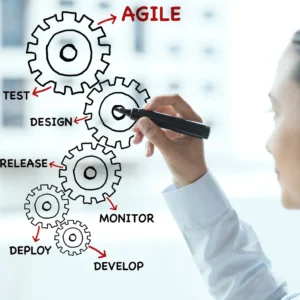
Navigating the Future
Comprehensive Strategies for Compliance and Security in Intelligent Process Automation (IPA) Excellence and Trustworthiness.
In the dynamic landscape of business and technology, integrating Intelligent Process Automation (IPA) has become instrumental in enhancing operational efficiency.
As organizations embrace automation’s transformative power, ensuring compliance and security is paramount. This article delves into the intricacies of “Compliance and Security in Intelligent Process Automation (IPA),” offering a comprehensive guide for business and technical solution providers.
Each aspect is meticulously explored, from regulatory compliance protocols to data privacy measures, secure data handling, and continuous monitoring.
We will navigate through strategies, innovative approaches, and governance frameworks, shedding light on the critical components of ethical AI practices, security in bot development, legacy system compatibility, and continuous compliance audits.
Join us as we unravel the strategies and protocols for a robust and secure Intelligent Process Automation ecosystem.
Regulatory Compliance Protocols
Strategies for Ensuring Adherence to Industry Regulations in Intelligent Process Automation (IPA):
In the context of “Compliance and Security in Intelligent Process Automation (IPA),” navigating industry regulations is a critical facet. Organizations should adopt strategic approaches that align with specific regulatory requirements to ensure adherence.
Implementing governance frameworks is fundamental. These frameworks provide a structured foundation for maintaining regulatory compliance throughout the automation processes. By integrating these frameworks seamlessly, organizations can establish standardized procedures that adhere to industry standards.
Continuous monitoring and enforcement protocols play a pivotal role. These protocols ensure compliance standards are consistently met and provide a mechanism for swift corrective actions in case of deviations. This real-time approach is vital for the dynamic nature of regulatory landscapes in IPA.
Innovation is critical to navigating evolving regulatory landscapes. Organizations must adopt proactive and dynamic compliance measures that facilitate real-time adaptation to regulatory changes. User-centric design principles further optimize compliance workflows in UI/UX, enhancing the overall effectiveness of the automation process.
Proactive compliance audits form an integral part of the strategy. Regular assessments help in ongoing assurance, identifying areas of improvement, and ensuring that compliance measures remain robust. Adaptive protocols for iterative enhancements based on compliance insights refine the automation processes over time.
For cross-border automation processes, security and compliance are paramount. Implementing collaborative platforms and tools fosters efficient communication and coordination, ensuring seamless adherence to regulatory requirements across diverse geographical boundaries. This collaborative approach is crucial in the global landscape of IPA, where regulatory frameworks may vary.
Data Privacy Measures
Strategic Implementation of Data Privacy Measures in Compliance and Security in Intelligent Process Automation (IPA):
In the “Compliance and Security in Intelligent Process Automation (IPA) landscape,” safeguarding sensitive information is a cornerstone. Protocols for protecting personal data within automation workflows are crucial, demanding a strategic and comprehensive approach.
The implementation of data privacy regulations and best practices is non-negotiable. Organizations must proactively adopt innovative approaches to integrate these regulations seamlessly into the fabric of IPA. This involves meeting and exceeding regulatory requirements to ensure robust data privacy protection.
Balancing automation with human oversight is essential for enhanced data privacy. Adapting to changing situations is crucial to maintain data confidentiality. Governance frameworks play a pivotal role in fostering ethical and transparent data privacy practices within the realm of IPA.
Proactive encryption methodologies are paramount. These methodologies secure data storage and transfer in automation, mitigating risks associated with unauthorized access. Adaptive data privacy protocols cater to varied automation scenarios and user preferences, demonstrating a commitment to personalized and secure experiences.
User-centric design principles optimize user experience in privacy-focused UIs. By prioritizing usability and clarity, organizations can ensure that users can interact seamlessly with IPA systems while maintaining a strong focus on data privacy.
Organizations must be vigilant and proactive to ensure compliance with global data privacy standards and regulations. This includes staying abreast of evolving standards, adapting protocols accordingly, and implementing measures that transcend geographical boundaries, fostering a universal commitment to data privacy in Intelligent Process Automation.
Secure Data Handling and Processing
Strategies for Ensuring Secure Handling of Data in Compliance and Security in Intelligent Process Automation (IPA):
In the “Compliance and Security in Intelligent Process Automation (IPA) landscape,” safeguarding data throughout its lifecycle is imperative. Robust strategies are essential to protect data at rest, in transit, and during processing in automation workflows.
Implementing protocols for safeguarding data at rest, in transit, and during processing is foundational. These protocols create a comprehensive shield against potential vulnerabilities, ensuring that sensitive information remains secure across all phases of automation.
Innovative approaches to encryption methodologies are pivotal.
Organizations must adopt cutting-edge techniques to fortify data security in IPA. Balancing automation with human oversight is crucial for enhanced security in data handling, mitigating risks associated with automated processes and human interactions.
Dynamic strategies are necessary for secure storage and retrieval of data in automation workflows. Governance frameworks play a crucial role in establishing ethical and transparent practices in secure data processing within the realm of IPA.
Proactive measures ensure the security of sensitive information throughout the data lifecycle. Adaptive data security protocols cater to varied automation scenarios and user preferences, showcasing a commitment to personalized and secure experiences.
User-centric design principles optimize user experience in secure data UIs. Prioritizing usability and clarity ensures that users can seamlessly interact with IPA systems while maintaining a strong focus on data security.
Organizations must take proactive measures to ensure compliance with security regulations and standards. This involves staying abreast of evolving security standards, adapting protocols accordingly, and implementing measures that uphold the highest security standards in data-driven automation processes.
Access Controls and Authentication
Strategies for Robust Access Controls in Compliance and Security in Intelligent Process Automation (IPA):
Ensuring the sanctity of sensitive information within “Compliance and Security in Intelligent Process Automation (IPA)” necessitates the implementation of robust access controls. These controls form an essential layer of defence against unauthorized access, providing a secure foundation for automation workflows.
Implementing protocols for secure user authentication is fundamental in IPA environments. This involves adopting mechanisms that rigorously verify user identities, preventing unauthorized entry. Balancing automation with human oversight is achieved through best practices in access control, mitigating risks associated with automated processes and human interactions.
Innovative approaches to role-based access and permissions enhance security in automation. Dynamic strategies are imperative for restricting unauthorized access to data and processes and adapting to the evolving landscape of potential security threats.
Governance frameworks play a crucial role in ethical and transparent access control implementation. Proactive authentication protocols ensure robust user identity verification, a cornerstone in preventing unauthorized access in automation environments.
Adaptive access control measures cater to varied automation scenarios and user roles, ensuring a personalized yet secure user experience. User-centric design principles further enhance this experience in access-controlled UIs, prioritizing usability and clarity.
Organizations must adopt measures that align with industry requirements to ensure compliance with security regulations and standards. This includes staying informed about evolving security standards, implementing protocols accordingly, and upholding the highest standards of access controls in compliance and security for Intelligent Process Automation.
Continuous Monitoring and Threat Detection
Strategic Protocols for Continuous Monitoring in Compliance and Security in Intelligent Process Automation (IPA):
In “Compliance and Security in Intelligent Process Automation (IPA),” continuous monitoring and threat detection are pivotal components in safeguarding automation workflows. Dynamic security measures are essential for real-time monitoring, ensuring a proactive stance against potential security threats.
Innovative approaches to real-time threat detection in IPA environments are critical. These methods employ advanced technologies and methodologies to detect and respond to security threats quickly, minimizing the impact on automated processes.
Balancing automation with human oversight is achieved through dynamic security monitoring. By implementing protocols that allow real-time identification and mitigation of security threats, organizations strike a crucial balance between automated processes and human intervention.
Dynamic strategies are imperative for the proactive identification and mitigation of security threats. Governance frameworks are essential for ensuring ethical and transparent practices in threat detection in IPA, promoting trust and accountability.
User-centric design principles optimize the user experience in security monitoring UIs. Adapting security protocols based on threat intelligence enhances the effectiveness of continuous monitoring.
Adaptive threat detection protocols cater to varied automation scenarios and user preferences, demonstrating a commitment to personalized and secure experiences. To achieve compliance with security regulations and standards, collaborative platforms and tools play a vital role in implementing and managing continuous security monitoring. This fosters a collective and vigilant approach to Intelligent Process Automation.
Ethical and Transparent AI Practices
Strategies for Ethical and Transparent AI Practices in Compliance and Security in Intelligent Process Automation (IPA):
“Compliance and Security in Intelligent Process Automation (IPA)” demands an unwavering commitment to ethical and transparent AI practices. Addressing biases and ensuring fairness in AI-driven decision-making is paramount, necessitating strategic measures.
Governance frameworks are crucial in ensuring fairness and accountability in AI-driven processes within IPA. These frameworks establish guidelines that govern the ethical use of AI technologies, fostering a culture of responsibility and transparency.
Protocols for addressing bias and promoting diversity in AI-enhanced workflows are foundational. By implementing measures that identify and mitigate biases, organizations can ensure that AI-driven processes align with ethical standards and promote inclusivity.
Balancing automation with human oversight involves ethical decision-making in AI. Innovative approaches, such as explainable AI, enhance transparency in decision-making, allowing users to comprehend the rationale behind AI-driven actions.
Dynamic strategies are imperative for the proactive identification and mitigation of AI-related biases. User-centric design principles optimize the user experience in ethical AI interaction, ensuring clarity and user understanding.
Adaptive protocols enable iterative enhancements based on ethical and transparent AI insights. Organizations must adhere to ethical guidelines and standards to ensure compliance, aligning their AI-driven automation processes with global ethical considerations.
Collaborative platforms and tools facilitate implementing and managing ethical AI practices in IPA. By fostering a collective approach, organizations can collectively strive towards the ethical use of AI, promoting trust and accountability in the landscape of Intelligent Process Automation.
Security Protocols in Bot Development
Strategic Security Protocols for Ensuring Secure Bot Development in Compliance and Security in Intelligent Process Automation (IPA):
“Compliance and Security in Intelligent Process Automation (IPA)” underscores the significance of secure bot development. Implementing strategic security protocols is essential to safeguarding automated bot processes and ensuring their integrity.
Governance frameworks are pivotal in instilling ethical and transparent security practices in bot development. These frameworks establish guidelines that govern secure coding practices, fostering a culture of responsibility and transparency in creating automated bots.
Innovative approaches to secure coding practices in bot development are foundational. Balancing automation with human oversight involves robust security measures, ensuring the development process aligns with the highest security standards.
Dynamic strategies are imperative for protecting sensitive information in automated bot processes. Proactive measures guarantee the integrity and security of bot-driven automation workflows, mitigating risks associated with unauthorized access or data breaches.
Adaptive security protocols cater to varied bot development scenarios and environments. User-centric design principles optimize the user experience in secure bot interaction, emphasizing clarity and ease of use.
Organizations must adhere to ethical guidelines and implement security measures aligned with industry requirements to ensure compliance with security regulations and standards. Collaborative platforms and tools facilitate implementing and managing security measures in bot development, fostering a collective and vigilant approach in the landscape of Intelligent Process Automation.
Legacy System Compatibility and Security
Strategies for Ensuring Legacy System Compatibility in Compliance and Security in Intelligent Process Automation (IPA):
Maintaining security when integrating Intelligent Process Automation (IPA) with legacy systems requires meticulous strategies. Protocols for the secure integration of legacy systems into automation workflows form the bedrock of this effort.
Innovative approaches to maintaining security in legacy system compatibility are crucial. Balancing automation with human oversight involves secure interactions with legacy systems, ensuring a seamless integration that aligns with the highest security standards.
Dynamic strategies are imperative for updating and securing outdated technologies within legacy systems. Governance frameworks are crucial in ensuring the ethical implementation of security measures and fostering trust and accountability in legacy system integration.
Proactive measures are essential for identifying and mitigating security risks in legacy system integration. Adaptive security protocols cater to varied scenarios and environments, ensuring a personalized yet secure user experience in legacy system compatibility.
User-centric design principles optimize user experience in legacy system compatibility, prioritizing clarity and ease of use. Organizations must adhere to ethical guidelines and implement security measures aligned with industry requirements to ensure compliance with security regulations and standards. This collective and vigilant approach safeguards legacy system integration in the landscape of Compliance and Security in Intelligent Process Automation (IPA).
Continuous Compliance Audits
Strategic Implementation of Continuous Compliance Audits in Compliance and Security in Intelligent Process Automation (IPA):
Ensuring ongoing compliance with regulations and standards within Intelligent Process Automation (IPA) necessitates a systematic approach. The strategic implementation of continuous compliance audits involves protocols for regular assessments, guaranteeing adherence to evolving regulatory frameworks.
Governance frameworks establish the foundation for regular audits, ensuring ongoing adherence to regulations. Comprehensive assessments and assurance protocols form the core of continuous compliance audits, systematically evaluating compliance levels and identifying areas for improvement.
Balancing automation with human oversight is achieved through regular compliance auditing processes. Innovative approaches involve continuous monitoring and adaptation to regulatory changes, ensuring that automation processes align with the latest compliance requirements.
Dynamic compliance audit strategies enable real-time evaluation of automation processes. User-centric design principles optimize the experience in compliance audits, prioritizing clarity and user-friendly interfaces.
Proactive measures are essential for identifying and addressing compliance gaps in automation workflows. Adaptive protocols facilitate iterative enhancements based on continuous compliance insights, allowing organizations to evolve and adapt to changing regulatory landscapes.
Collaborative platforms and tools are crucial for implementing and managing continuous compliance audits in IPA. By fostering a collective and vigilant approach, organizations can ensure sustained compliance and security in the landscape of Intelligent Process Automation.
Security Training and Awareness Programs
Strategic Implementation of Security Training Programs in Compliance and Security in Intelligent Process Automation (IPA):
To fortify “Compliance and Security in Intelligent Process Automation (IPA),” organizations must prioritize comprehensive security training and awareness programs. Protocols designed to elevate security awareness among personnel within automation workflows are foundational in fostering a culture of security and compliance.
Innovative approaches to employee education are pivotal. Balancing automation with human oversight requires robust security training initiatives, ensuring personnel have the knowledge and skills to uphold security standards in IPA environments.
Dynamic strategies are essential for the continuous improvement of security knowledge and skills. Governance frameworks play a crucial role in the ethical and transparent implementation of security training, fostering a culture of responsibility and accountability.
It is proactive to create a culture of security and compliance within an organization to reinforce the importance of individual contributions to the overall security posture. Adaptive training protocols cater to varied employee roles and security awareness levels, ensuring personalized and compelling learning experiences.
User-centric design principles optimize the user experience in security training programs, emphasizing clarity and engagement. This approach ensures that employees understand security protocols and actively contribute to the collective security goals.
Comprehensive training initiatives align with security regulations and standards, ensuring that organizations are compliant and actively strive towards heightened security in the landscape of Intelligent Process Automation.
Conclusion
In conclusion, the landscape of Intelligent Process Automation (IPA) stands as a transformative force, reshaping how businesses operate and innovate. Throughout this comprehensive guide on “Compliance and Security in Intelligent Process Automation (IPA),” we have navigated the intricacies of protocols, strategies, and frameworks essential for a resilient and secure automation ecosystem.
From addressing regulatory compliance to fortifying data privacy measures, securing bot development, ensuring legacy system compatibility, and conducting continuous compliance audits, organizations must embrace a holistic approach to mitigate risks and foster trust.
Ethical and transparent AI practices are central in aligning automation with human values, while user-centric design principles optimize the user experience in security-focused interactions.
The journey through adaptive and dynamic strategies underscores the need for a proactive stance in the ever-evolving landscape of technology.
As collaborative platforms and tools facilitate the implementation and management of security measures, organizations are empowered to stay compliant with global standards while adapting to emerging threats.
Businesses and technical solution providers can navigate the complexities of Compliance and Security in Intelligent Process Automation by following the principles outlined in this guide. This can foster a culture of responsibility, transparency, and resilience in the face of evolving challenges.
This holistic approach ensures that Intelligent Process Automation continues to drive innovation, efficiency, and security in the modern business landscape.
Related Articles
- Choosing the Right Automation Tool in 7 Steps
- A 9-Step Guide to IPA Implementation: Energise Your Operations
- Navigating the Roadblocks of IPA – The Top 9 Challenges
- AI in Intelligent Process Automation – Unleash the Power of AI
- 9 IPA Examples in Small-Scale Industries
- Power of Intelligent Business Process Automation – Efficiency
- AI Business Process Management: Unleashing the Power
- Business Process Management with AI Integration
- AI for Reengineering Business Processes
- Hyperautomation: Redefining BPM with AI
- The Role of AI in Business Process Modelling
- AI-driven Customer Onboarding – Unleash the Power of AI
- Effective Process mapping in Intelligent Process Automation
- Intelligent Process Automation Adoption – The Best Strategy Guide
- TechInfra in IPA: A Comprehensive Guide
- Elevating Intelligent Automation with Continuous Improvement
- Comprehensive Approach to Cost-Benefit Analysis in IPA
- Vendor Selection in IPA – Comprehensive Guide
- Implementing Agile in Intelligent Process Automation (IPA)
- Scalability and Integration in Intelligent Process Automation
- Cognitive Automation in IPA: Innovating Ethical Efficiency
- Mastering Symphony: Bot Development in IPA Unveiled
- UI/UX Mastery in IPA: Elevating Automation Experiences
- Compliance and Security in IPA – A Guide Ensuring Trust
- Impact of Performance Monitoring and Analytics in IPA
- Driving Success: Data Management in IPA
- Crucial Role: Documentation in IPA Triumph
- Optimizing IPA – Continuous Improvement Strategies




































